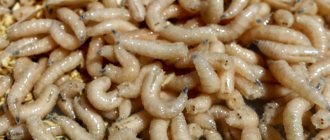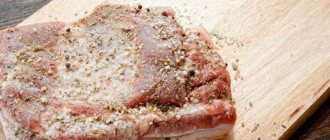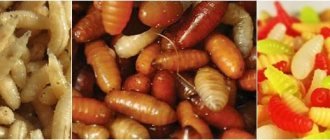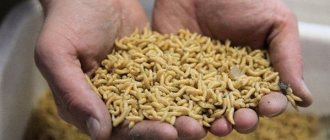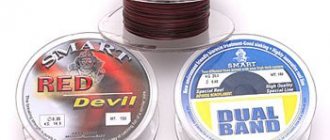Breeding at home
Maggot for fishing is made at home as follows:
- Take 200 grams of fish or meat.
- Cut into pieces the size of a matchbox and place in a plastic bag.
- We tie it tightly. This is necessary in order to speed up the decomposition process.
- Leave in a warm place for a day.
- The temperature must be at room temperature, otherwise the meat will simply go rotten.
- After a day, the resulting meat is placed in a low container filled with sawdust.
- Cover the container with a cloth so that there are gaps left - flies will fly into them.
- After some time, maggot larvae will appear, all that remains is to feed them.
Young maggots are very active, if you notice they stop moving then your bait will soon turn into a chrysalis, time to use it ASAP!
- You will have to feed the maggot for 3-4 days. There is no point anymore since it stops growing.
- Foods that can be used are foods high in protein - liver, lungs, chicken eggs.
- Feeding proceeds as follows: first, sawdust is poured, then food, and only then the larvae come.
- Don't forget to change the bedding and ventilate the containers.
- After the maggot is ripe, it is placed in the cold until you go fishing.
In the egg

How to grow large maggots? The simplest way is in an egg. Its advantage is the minimum cost of money, time and effort. The disadvantage of this method is that only a few larvae can be grown in one egg (twenty or thirty pieces). But it can be easily compensated for by using several eggs.
How to grow maggots using the presented method:
- Boil an egg. It must be hard-boiled.
- You will need to remove the shell from the top.
- In this form, the workpiece should be left in a shaded place in the open air.
- When the product goes rotten, flies will flock to it. They will lay their eggs inside.
- The hatched larvae will grow in the shell without falling out of it. You can place the eggs in a special container with dry filler (sawdust, wood shavings, etc.). If the larvae manage to get out of the shell, they will still remain in the litter.
Once the desired size is reached, the bait is easily removed from the shell.
Second breeding method
In this case, all work is carried out as in the first option, but it looks more and more aesthetically pleasing. You will need a plastic bottle. Cut it so that you get a glass and a plastic neck. Insert the neck into the glass, first unscrewing the cap and turning it over. Sawdust is poured into the bottom of the glass, about 1 cm thick. The larvae are poured into the inverted neck. After the maggot grows, it will roll down the walls of the neck into the glass. In this case, the larvae need feeding.
How to organize sales
Important: the success of your business will largely depend on the sales of your products.
To calculate the average monthly need for this product in your area, you need to calculate how many stores are located in the serviced area.
For example, a small store usually sells about 200 cans of white maggots and another 100 of colored ones per week. As for large fishing stores, this number reaches 2000 cans per week. But in any case, as they say, it’s a matter of practice. And after some time, you will know exactly at what capacity to organize production in order to fully cover the market need.
To better understand the features of such a business, you need to find out the average prices for this product. Below we will consider the average cost of maggots in fishing stores in the Russian Federation:
- White maggot (30 ml capacity): 12-14 wholesale and 30-35 retail;
- Dyed maggot (30 ml capacity): 14-16 wholesale and 30-50 retail;
- White maggot (1 liter capacity): 350-400 wholesale and 600-700 retail;
- Dyed maggot (1 liter capacity): 450-500 wholesale and 700-800 retail;

As a rule, most manufacturers sell their products according to the following scheme. Unpackaged maggots are purchased in liters. Then the intermediary puts it into containers at his discretion. At the same time, the jars may have labels with the logo of another manufacturer. The product is then sold to all existing retail outlets. In a small region there may be up to three such intermediaries.
Considering the above circumstances, manufacturers want such dealers to be under their leadership and work under their brand. But as you know, the peculiarity of this business lies in its seasonality: during peak months, requirements for goods increase significantly, so the client wants larger maggots. But overloading production capacity is simply not possible to produce the desired result. Therefore, dealers are looking for a manufacturer whose products would meet demand. And in this case, there is a kind of migration of employees from one company to another. Eventually market conditions change and everything returns to normal.
As for the owners of large and medium-sized stores, naturally the majority strives to do without the services of intermediaries. In this case, they begin to cooperate with those manufacturers who supply packaged goods. But products of this type have a large volume, and their delivery is correspondingly more expensive. The same conductors or, say, bus drivers usually charge a certain price for transporting one box. Thus, the cost of the entire batch increases, which is accordingly unprofitable for intermediaries. After all, their main profit comes from reducing transport costs. Additionally, they are trying to increase profits by reducing the number of maggots in the banks themselves. As a result, they make many times more profit from one liter than the manufacturer.
To calculate the cost of one liter of biomass, you must use the following formula:
(Price per 1 kg of raw materials * 2.5) + payroll + electricity costs
Based on this formula, we can conclude that if you do not plan to hire third-party workers, and the raw materials themselves were practically free (the death of chickens at a poultry farm), then the cost of your product will consist only of heating and electricity costs. The cost of the container (a jar with a 30 ml label) for the retail sale of maggots is three rubles. Accordingly, this type of business is quite profitable.

Important: one liter of maggots allows you to get about 60 jars of finished products for delivery to retail stores.
Gallery: maggots for fishing (25 photos)
Hooking
It is very important to place the larva on the hook correctly! The puncture should go in the place of the head at the level of the eyes. There are several ways to do this: only part of the larva’s body is hooked or the entire body is hooked longitudinally.
Many species of fish are interested in the presented bait. The classic option for catching large specimens is several maggots on a hook. If you see that, for example, after the bream’s work, only the skins of the larvae remain, it’s time to plant new maggots. You will see that the bite will become much better.
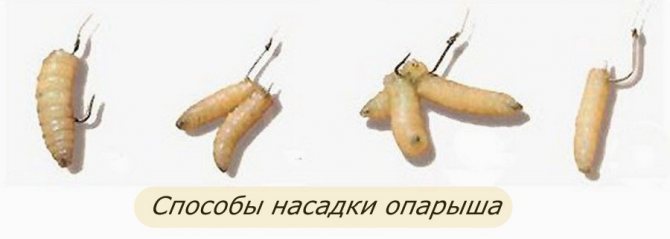
If the bite is active, the back of 1-3 larvae is pierced. If there is little interest from the fish, the best option is to pierce through it. Important! The tip of the hook must be outside the maggot, otherwise the fish will likely escape.
Special device

Many fishermen strive to grow bait so that contact with it is minimal. For this purpose, you can design a special device. It consists of three containers of different volumes, which are inserted into one another.
- Place meat or fish in the top container. It is closed with a lid with holes. It should also have a holey bottom.
- The middle container also has holes at the bottom. Dry filler is placed in it.
- The lower container is filled with the same filler and serves to collect clean larvae.
The operating principle of this device is as follows:
- Meat or fish is placed in the upper part and the device is placed in a shaded place where flies can find it.
- If after two or three days the insects lay eggs, the top part is covered with a lid with holes. The manufactured device is placed in the designated place.
- The grown larvae fall through holes in the bottom into the middle part.
- After passing through a layer of dry filler, the larvae are cleaned and fall into the lower container. From here they are removed and placed in jars for storage and further use.
The whole process lasts from seven to ten days depending on the air temperature.
What kind of fish will be interested in bait?
Maggots grown at home are a tasty morsel mainly for peaceful fish. These are roach, crucian carp, redeye and carp. The effect of maggots is almost the same as that of a dung worm.
Sometimes the larva is also of interest to predators. Fishing occurs with both float and bottom tackle. You can learn more about the secrets of bottom rigging in our previous publications. Maggots are often used as bait.
Maggot is a popular bait among fishermen, but it is best to prepare it at home. There are several ways to breed bait. The main thing is to seize the moment and prevent the larvae from pupating. Both peaceful and predatory fish are interested in the bait. Among other things, maggots are often used as bait.
Preparatory part
The maggot develops quite quickly and under the most favorable conditions, this type of worm develops quickly and moves on to the next stage with the development of pupation.
A set of the following actions can help slow down this unfavorable process for the fisherman:
- It is recommended to store maggot larvae at a temperature that is close to zero - this is due to the fact that if it is lower, the larvae will simply die. At low temperatures, the life process of maggots stops a little and it is stored for quite a long time - about two months.
- In order to store maggots, the container with a lid must be thoroughly rinsed, completely dried, and after that, the larvae can be placed.
- It is best to store the larvae in ordinary sawdust of any type of deciduous tree.
